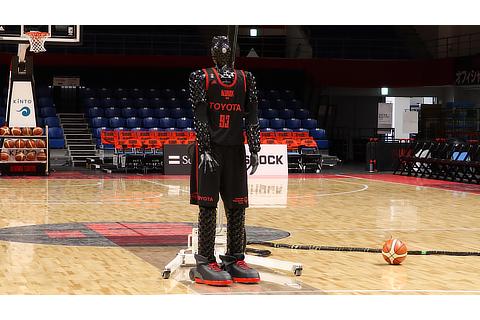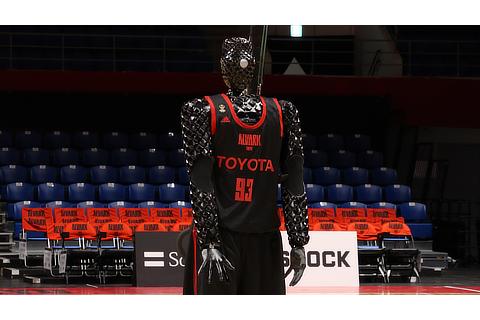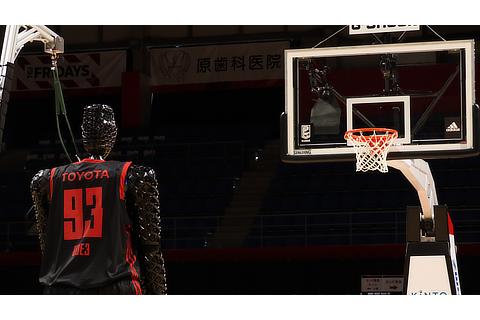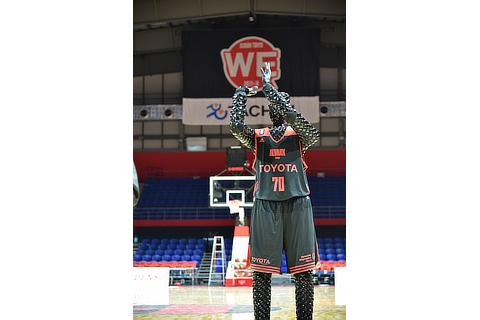Mar. 29, 2019
The Development Diary of CUE, the AI Basketball RobotAn in-house challenge: novices embark on a new project from scratch
- CUE was originally developed by Toyota volunteers in their free time as an AI basketball-playing robot that scores 100 percent of its shots
- The new CUE3 is scheduled to be unveiled on April 10, 2019, at the B.League match between Alvark Tokyo and Sunrockers Shibuya
"A basketball-playing robot developed by Toyota has apparently been registered as a player by the Alvark Tokyo ("Alavark") professional basketball team in Japan." Upon hearing this rumor, I immediately took a look at the Alvark website. Sure enough, there it was. Clearly different in appearance to the other players, I immediately spotted it. Its name was CUE2, and its profile stated it was from Toyota City, Aichi Prefecture.
-

- Taken from the Alvark Tokyo website (as of February 2019)
In the history of the Japanese professional basketball league, this is the first time ever that a robot has been registered as a player. But what, exactly, is CUE? The robot's name is CUE2, which suggests there was a CUE1... and, upon further investigation, I found what appeared to be the first-generation CUE on YouTube. Number of views... 320,000!? That's more views than Toyota's new model introduction videos get!
In any case, it seems true that Toyota is developing a basketball playing robot―but why now? The automotive industry is said to be facing a once-in-a-century period of major upheaval―surely Toyota doesn't have time to be developing a basketball playing robot?! No doubt many people think the same. What significance has Toyota identified in developing a basketball playing robot? I intend to charge headlong into finding the answer.
Inspired by an in-house volunteer organization!?
At present, CUE is being developed by the AI Athlete Robot Development Group, Frontier Research Center. However, CUE has its roots in an event hosted by the Toyota Engineering Society, Toyota's oldest in-house volunteer organization. The theme of the event was "Absolute beginners take up the challenge of developing AI from scratch." AI, which stands for "Artificial Intelligence," refers to artificial systems that make decisions and carry out tasks using human-like intelligence; for this reason, AI has to "learn" in the same way as humans. The team members soon began studying AI, but they had no idea what or how much to study. When discussing how much to study, one of the team members uttered a phrase used by Hanamichi Sakuragi, the protagonist of the renowned basketball comic, SLAM DUNK: "Will 20,000 practice shots be enough?" This led to the following idea: "Wouldn't it be amazing if we developed a robot that could use AI to calculate the distance to the goal by itself, and sink 100 percent of its shots?" And this was the exact moment that development of CUE began.
The Toyota Engineering Society
Inaugurated in 1947, the Toyota Engineering Society―or "TES" for short―is Toyota's oldest voluntary organization, and celebrated its 70th anniversary in 2017. The goals of its activities are to improve the technical skills and talents of its members, promote camaraderie, and contribute to the development of technological fields in various areas of business. At present, it has approximately 30,000 members.
An unexpected response
The team had zero experience of developing robots and were also complete beginners when it came to AI; the members therefore studied from scratch and, through a process of trial and error, developed the first-generation CUE. The robot was unveiled at a TES event that was open to members of the public. CUE took 10 shots during the event, and successfully scored 9 of them (rumor has it that CUE failed to score one of his shots due to nerves, when an executive came to watch). The project was supposed to end here; however, afterwards, the team was approached by Alvark Tokyo and, on March 28, 2018, CUE took part in a shooting performance during a half-time show at an Alvark match. The unexpectedly enthusiastic response can be gauged by the number of views in the YouTube video link above.
Alvark Tokyo
Alvark Tokyo plays in the B.League, a professional men's basketball league in Japan. One of the strongest teams in Japan, Alvark Tokyo features a number of players that have represented the Japanese national team―including Yudai Baba, Joji Takeuchi, and Daiki Tanaka―and won the league in the 2017―2018 season. The team's offices are located on the 12th floor of Toyota's Tokyo Head Office.
The CUE volunteer project becomes "work"
Following the reaction to the first-generation CUE, the Toyota management suggested―"It's an interesting project, so why don't you continue it for a little while longer?"―and gave the team two years to develop a next-generation CUE. Since the project was now officially part of their work, the team had to take responsibility and define and execute goals. Tomohiro Nomi, leader of the development team, explains the goals of the CUE project:
"When we were working on CUE as a TES project, our goal was to show others in the company that we were beginners taking up a new challenge from scratch; this would stimulate company employees into thinking "if they can do it, we can do it too," and "we will make our project even better than theirs." In this way, we wanted our project to be a reason―a "CUE," in other words―to promote work style reforms within the company.
"However, after we were given the opportunity to work on CUE as work, our attitude changed: we no longer wanted to develop "something that is amazing for a beginner"; instead, we wanted to develop "something that is amazing full stop." We wanted to do this in an extremely short period of time, and show everyone that Toyota was still relevant in the world of development. Through waku-doki (excitement and exhilaration) manufacturing, we also wanted to brighten and energize Japan."
It turns out that the CUE project requires no management approval; instead, all the work is fundamentally carried out at the team members' discretion. In order to minimize intermediary costs, the team members also procure parts themselves. Having been granted a period of two years for the project and allotted discretion and responsibility, the team itself decides what it should do as it embarks on the challenge of development. What sort of results will the project bring? Perhaps this is what Toyota is seeking to find out―and for this reason, the CUE development team carries a huge weight of expectation and pressure.
From CUE to CUE2
There was just half a year between CUE's debut and the unveiling of CUE2. In six months, the sturdy box on which CUE had stood had disappeared, leaving CUE2 to stand unsupported on its own two feet. But there was more: while CUE had only taken shots within the free-throw area, CUE2 was able to stand outside the three-point line.
According to Nomi: "The longer the shot distance, the greater the influence of small errors in movement. CUE2 is unable to score a three-pointer if the shot motion errs by even a single degree."
-
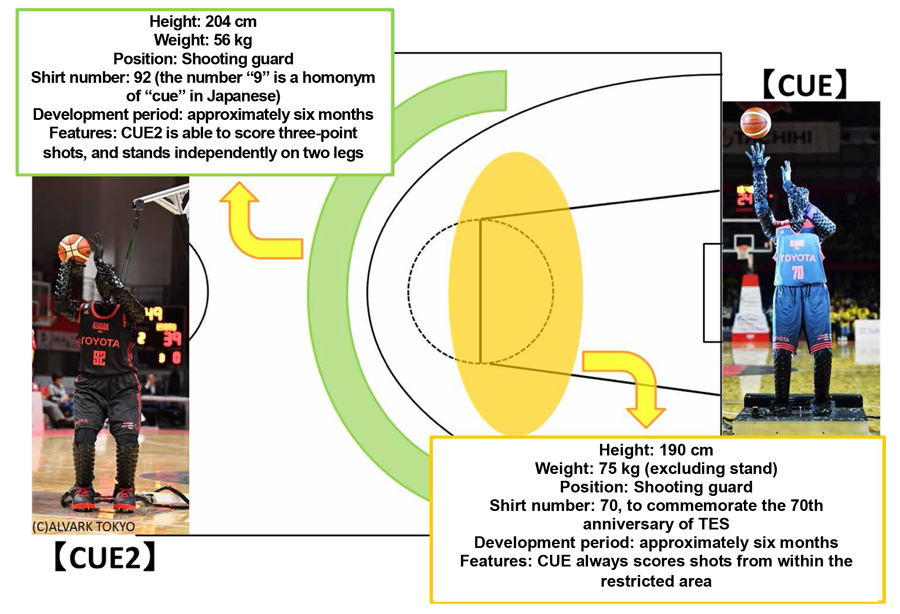
- The evolution of CUE
On November 24, 2018, CUE2 took part in a half-time show performance. The robot spectacularly sunk two three-point throws in a row (feeling positive, CUE development team then attempted to score from further away, but was unfortunately denied by the ring). In order to eliminate the foot stand, motors were made smaller and located inside CUE2's body; and, in order to enable CUE2 to throw the ball further, motor output was increased. The performance was only made possible because the team had overcome these technological hurdles.
Overcoming difficulties
It may appear that the development of CUE has thus far gone smoothly, with no significant problems to note. The reality, however, is completely different. Up until a week before its performance, CUE2 was unable to score even free-throws, much less three-point throws. The development team―which only numbers nine people―was making adjustments to the very end. Basically Toyota aims for 100 percent perfection when unveiling products to the public and, as a result, carries out extremely rigorous checks. This is only natural when it comes to cars and other products that are responsible for people's lives. However, the CUE project proceeded in an unprecedented manner―the team unveiled the robot even though it was unfinished, it learned from its mistakes and frustrations, and it embraced the challenge of moving ever-forward. In addition, one of the curious charms of the CUE development team was that, whenever it encountered problems, people gathered from various places to help out.
The staff at Alvark, for example, supported the development team by providing half a court to practice on for a week before the performance; the staff even helped with carrying the robot and machinery in and out of the court. Alex Kirk, meanwhile, agreed to be a model so that the team could simulate his shooting form. Nomi says with enthusiasm: "We are truly grateful to everyone at Alvark. We are determined to repay the kindness they showed us by contributing to the world of basketball in some way."
Within Toyota itself, other robot teams developing Partner Robots readily provided advice to the CUE development team when it faced technological problems. At Hirose Plant, which is located in Toyota City, Aichi Prefecture, and which is the main development center for CUE, engineers freely offered their expertise to build circuit boards, create the wiring―which extended to 600 meters in total―and produce the resin that would be used for CUE's external appearance. The CUE development team was able to overcome its obstacles thanks to assistance from many different quarters.
-

- Toyota Partner Robots
Toyota Partner Robots
Since 2004, Toyota has focused on developing Partner Robots, based on the concept of supporting human activity and coexisting with humans. From lifestyle support robots and humanoid robots to rehabilitation robots that support the early recovery of people with lower limb disabilities, Toyota Partner Robots are active in a wide range of fields, and support the mobility of all.
-

- Toyota Partner Robots
On to CUE3
On April 10, 2019, some five months after the unveiling of CUE2, CUE3 will make its debut appearance during the half-time show of the match between Alvark Tokyo and Sunrockers Shibuya. How will the latest version astonish us? Let us wait with bated breath.
Meanwhile, the challenges of the CUE development team are set to continue, with the goal of appearing in the 2020 B.League All Stars Game and more besides.
-

- The CUE development team and engineers at Hirose Plant
T.R.







